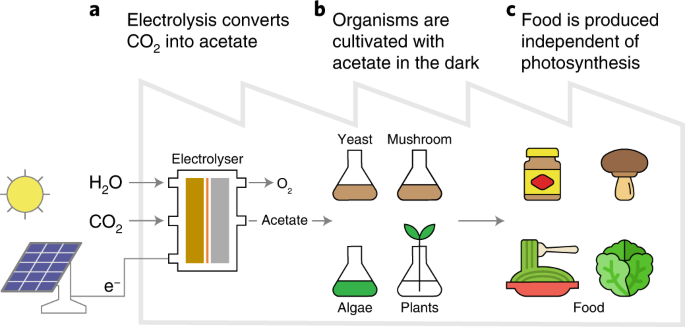科学者たちは、地球上、そしていつの日か火星での食糧生産をよりエネルギー効率の高いものにするために、人工光合成の開発に取り組んでいます。 Scientists are developing artificial photosynthesis to help make food production more energy-efficient here on Earth, and one day possibly on Mars
2022-06-23 カリフォルニア大学リバーサイド校(UCR)
この研究は、2段階の電極触媒プロセスを用いて、二酸化炭素、電気、水を酢の主成分の形である酢酸に変換するものである。食物を生産する生物は、暗闇の中で酢酸を消費して成長します。この有機-無機ハイブリッドシステムを、電極触媒を動かすための電力を生み出すソーラーパネルと組み合わせることで、太陽光から食品への変換効率が向上し、食品によっては18倍もの効率になる可能性があります。
<関連情報>
- https://news.ucr.edu/articles/2022/06/23/artificial-photosynthesis-can-produce-food-without-sunshine
- https://www.nature.com/articles/s43016-022-00530-x
エネルギー効率に優れた食料生産のための無機・生物ハイブリッド型人工光合成システム A hybrid inorganic–biological artificial photosynthesis system for energy-efficient food production
Elizabeth C. Hann,Sean Overa,Marcus Harland-Dunaway,Andrés F. Narvaez,Dang N. Le,Martha L. Orozco-Cárdenas,Feng Jiao &Robert E. Jinkerson
Nature Food

Abstract
Artificial photosynthesis systems are proposed as an efficient alternative route to capture CO2 to produce additional food for growing global demand. Here a two-step CO2 electrolyser system was developed to produce a highly concentrated acetate stream with a 57% carbon selectivity (CO2 to acetate), allowing its direct use for the heterotrophic cultivation of yeast, mushroom-producing fungus and a photosynthetic green alga, in the dark without inputs from biological photosynthesis. An evaluation of nine crop plants found that carbon from exogenously supplied acetate incorporates into biomass through major metabolic pathways. Coupling this approach to existing photovoltaic systems could increase solar-to-food energy conversion efficiency by about fourfold over biological photosynthesis, reducing the solar footprint required. This technology allows for a reimagination of how food can be produced in controlled environments.


